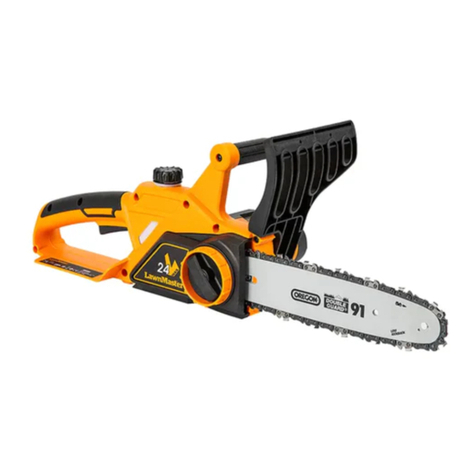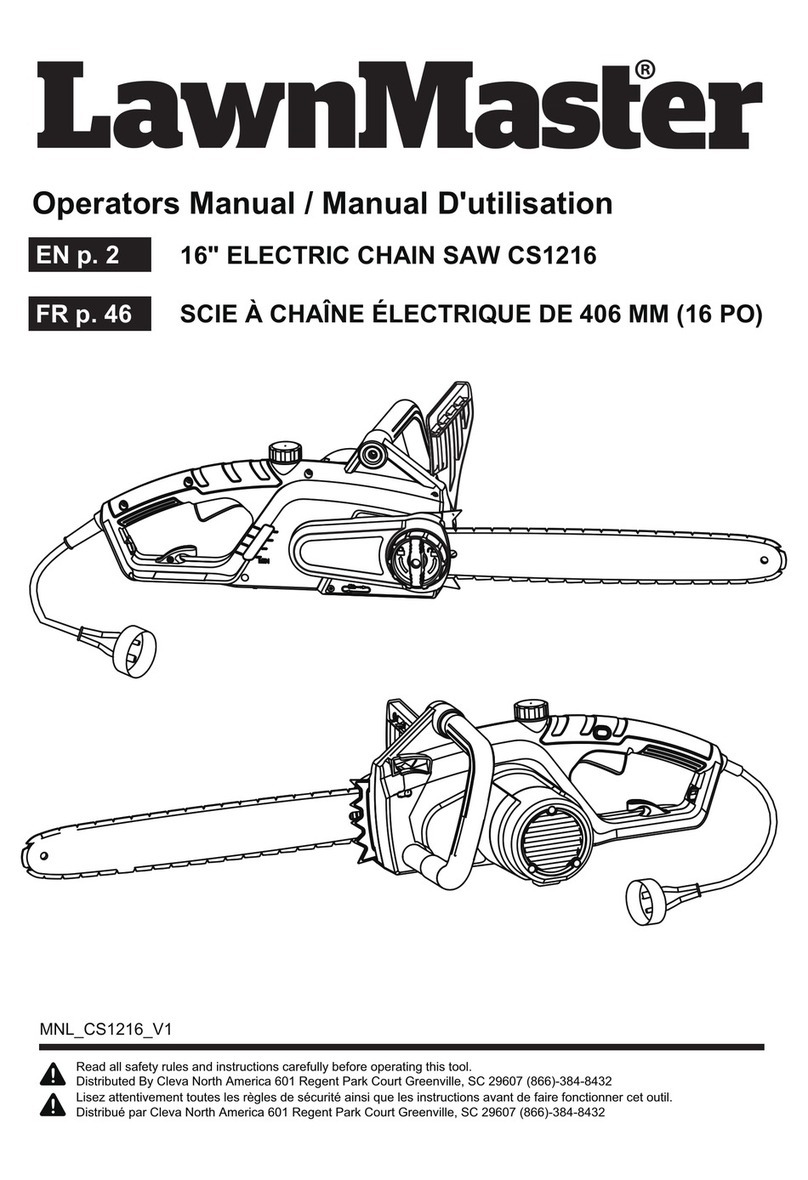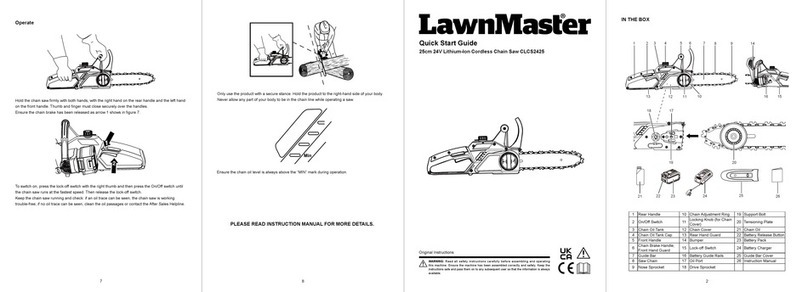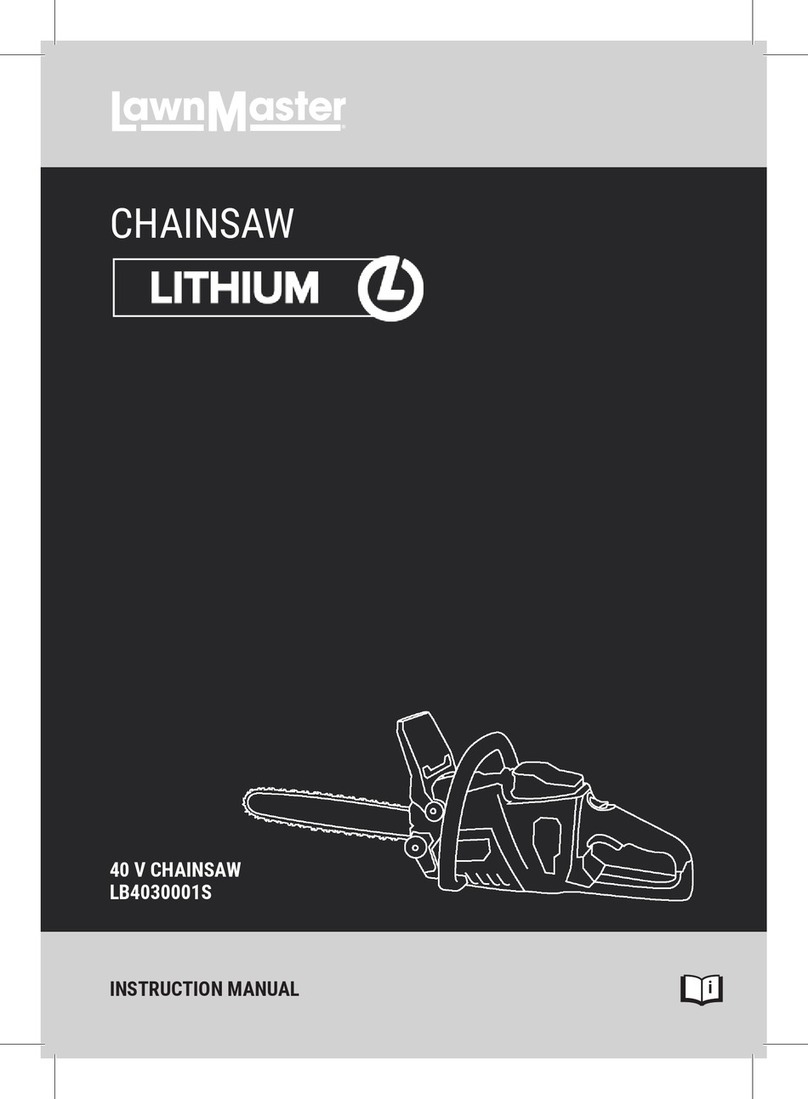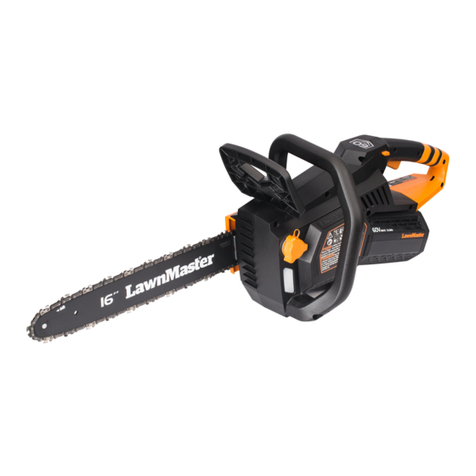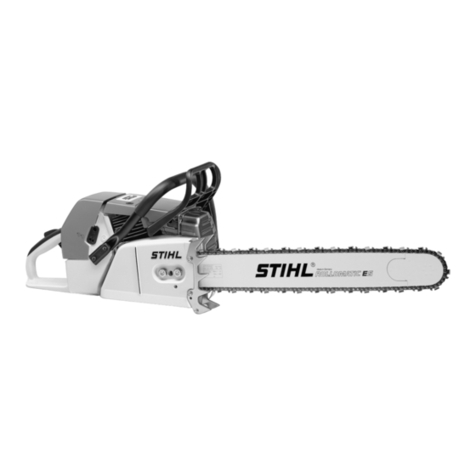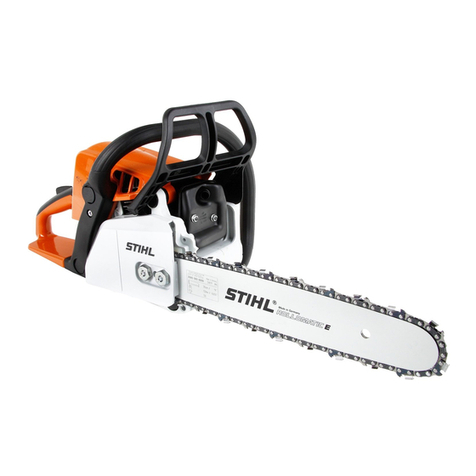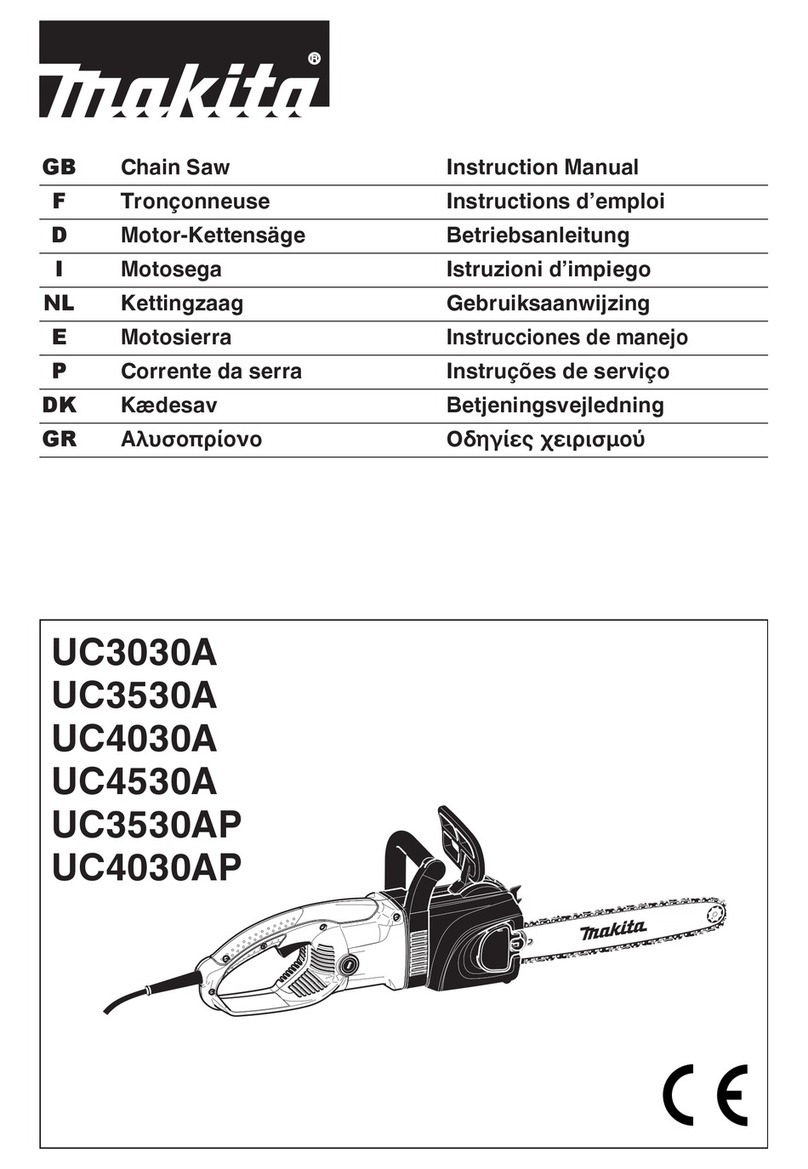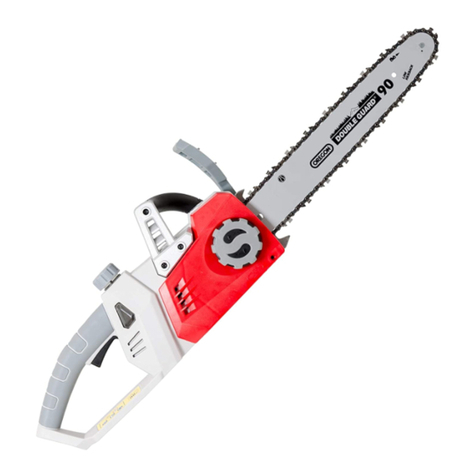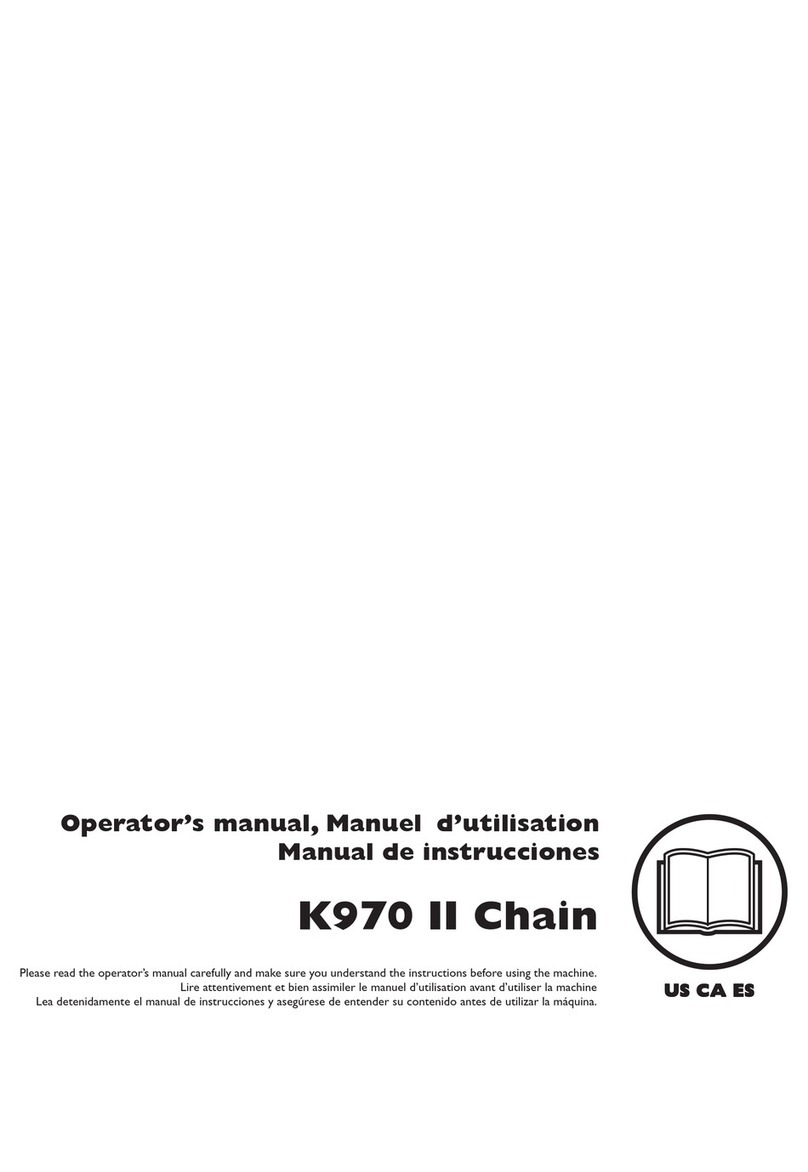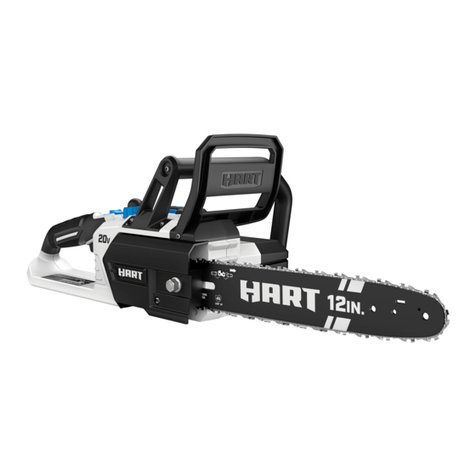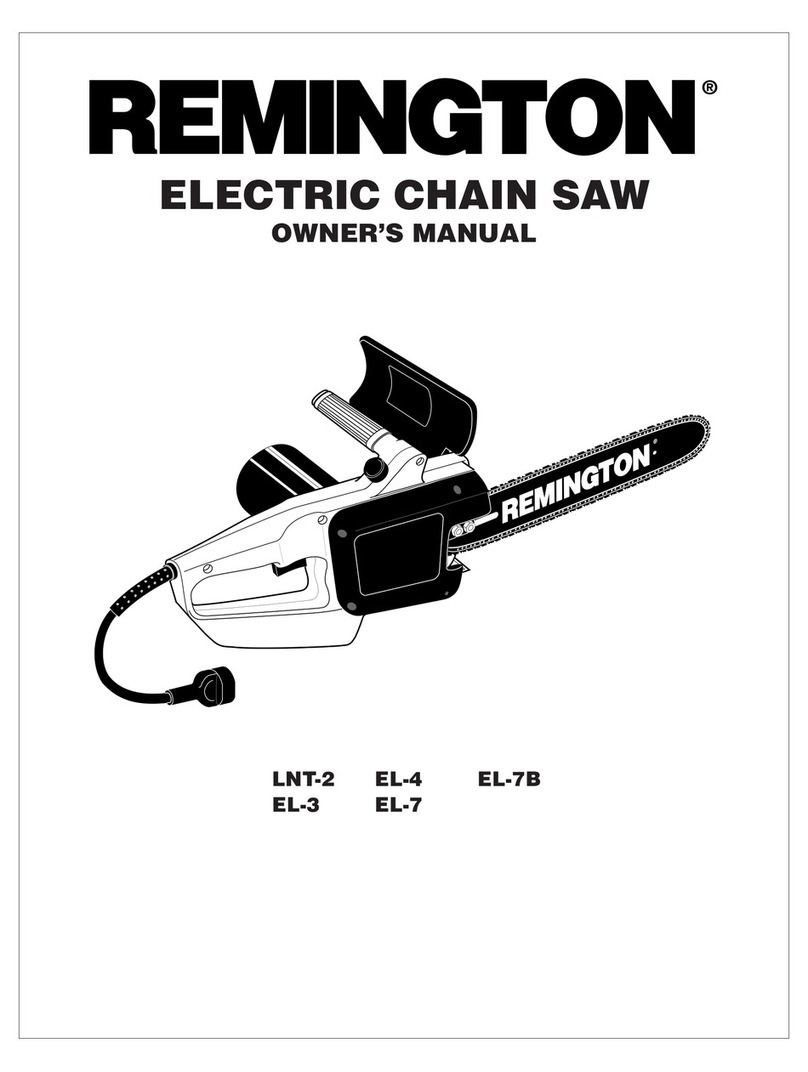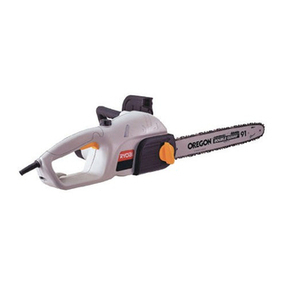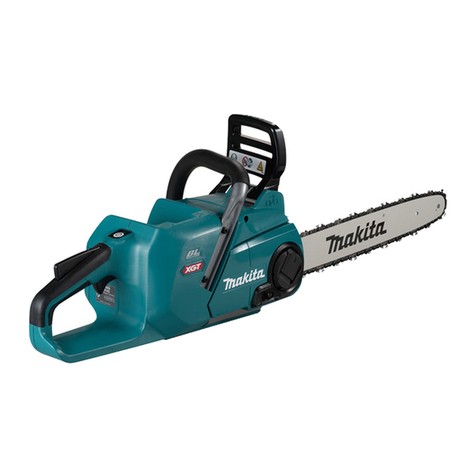LawnMaster CLCS2425-01 User manual

Instruction Manual
25cm 24V Lithium-Ion Cordless Chain Saw CLCS2425
CLCS2425-01 (With Battery and Charger)
CLCS2425-BARE (Battery and Charger Not Included)
Read all safety instructions carefully before assembling and operating
this machine. Ensure the machine has been assembled correctly and safely. Keep the
instructions safe and pass them on to any subsequent user so that the information is always
available.
WARNING:
Original Instructions


1 7
10
17
34
25
22
68 9
15
13
14
1112
16
2019
18
24 25
23 26
21
not included with CLCS2425-BARE

4
TABLE OF CONTENTS
Section Page
Symbols
Safety Information
In the Box
Assembly
Operation
Maintenance
Troubleshooting
Technical Data
Recycling and Disposal
5-7
8-18
19
20-21
22-29
30-32
33-34
35
36

5
SYMBOL DESIGNATION/EXPLANATION
Caution
Read instruction manual.
Read the instruction manual and follow all warnings and safety instructions.
Keep bystanders away.
Wear eye protection.
Wear ear protection.
Wear gloves with saw protection.
Use protective clothing.
Wear safety footwear.
Always use the chain saw with both hands. Do not use one hand when operating
the product.
Caution! Kickback! Tip contact may cause the guide bar to move suddenly
upward and backwards what may cause serious injury to user.
Contact of the guide bar tip with any object should be avoided.
Do not expose the chain saw to rain.
SYMBOLS
The following warning symbols appear throughout this manual and indicate the
appropriate safety measures you should take when operating and maintaining the
appliance.

6
SYMBOLS
SYMBOL DESIGNATION/EXPLANATION
Remove the battery from the chain saw before servicing it.
Symbol on locking knob: Open
Symbol on locking knob: Closed
Noise level specication Lwa in dB(A).
Guide bar length.
Correct direction of cutting-teeth.
Rell chain oil.
Protection class II (Double insulation)
Only recharge battery packs with the supplied charger indoors.
Fuse
Electrical appliances must not be disposed of with the domestic waste.
Batteries contain Lithium-ion. Do not dispose of batteries in household waste.
Do not dispose of battery packs in rivers or immerse in water.
Do not dispose of battery packs in re.
Do not subject the battery to direct sunlight over long periods and do not leave it
on or near a heat source (max. 60°C).
Recycle electrical waste products in an environmentally safe way where facilities
exist.
Li-ion
dB
L
WA
Open
Closed
T/3.15A

7
To avoid serious personal injury, do not attempt to use this product until you read thoroughly and
understand completely the instruction manual.
If you do not understand the warnings and instructions in the instruction manual, do not use this
product.
WARNING
SYMBOLS

8
SAFETY INFORMATION
Work Area Safety
■ Keep work area clean and well lit. Cluttered or dark areas
invite accidents.
■ Do not operate power tools in explosive atmospheres, such
as in the presence of ammable Iiquids, gases or dust.
Power tools create sparks which may ignite the dust or
fumes.
■ Keep children and bystanders away while operating a
power tool. Distractions can cause you to lose control.
Electrical Safety
■ Power tool plugs must match the outlet. Never modify the
plug in any way. Do not use any adapter plugs with earthed
(grounded) power tools. Unmodied plugs and matching
outlets will reduce risk of electric shock.
■ Avoid body contact with earthed or grounded surfaces,
such as pipes, radiators, ranges and refrigerators. There is
an increased risk of electric shock if your body is earthed or
grounded.
■ Do not expose power tools to rain or wet conditions. Water
entering a power tool will increase the risk of electric shock.
Read all safety directions and instructions. Omissions in
the compliance with safety directions and instructions can
cause electrical shock, re and/or severe injuries.
Save all warnings and instructions for future reference.
The term "power tool" in the warnings refers to your mains-
operated (corded) power tool or battery-operated (cordless)
power tool.
WARNING

9
SAFETY INFORMATION
■ If operating a power tool in a damp location is unavoidable,
use a residual current device (RCD) protected supply. Use
of an RCD reduces the risk of electric shock. Use a surge
protector with a release current of 30 mA or less.
Personal Safety
■ Stay alert, watch what you are doing and use common
sense when operating a power tool. Do not use a power
tool while you are tired or under the inuence of drugs,
alcohol or medication. A moment of inattention white
operating power tools may result in serious personal injury.
■ Use personal protective equipment. Always wear eye
protection. Protective equipment such as dust mask, non-
skid safety shoes, hard hat, or hearing protection used for
appropriate conditions will reduce personal injuries.
■ Prevent unintentional starting. Ensure the switch is in the
off-position before connecting to power source and/or
battery pack, picking up or carrying the tool. Carrying power
tools with your nger on the switch or energising power
tools that have the switch on invites accidents.
■ Remove any adjusting key or wrench before turning the
power tool on. A wrench or a key left attached to a rotating
part of the power tool may result in personal injury.
■ Do not overreach. Keep proper footing and balance at
all times. This enables better control of the power tool in
unexpected situations.
■ Dress properly. Do not wear loose clothing or jewellery.
Keep your hair, clothing and gloves away from moving
parts. Loose clothes, jewellery or long hair can be caught in
moving parts.

10
SAFETY INFORMATION
■ If devices are provided for the connection of dust extraction
and collection facilities, ensure these are connected and
properly used. Use of dust collection can reduce dust-
related hazards.
■ WARNING! During operation, this electric tool generates an
electromagnetic eld which, under certain circumstances,
may impair the functionality of active or passive medical
implants. To reduce the risk of serious or lethal injuries, we
recommend that persons with medical implants consult
their doctor and the manufacturer of their medical implant
before operating the machine.
■ Change your working position regularly. Long use of
the equipment can result in vibration-related circulatory
disorders in the hands. However, the length of use can be
extended by using suitable gloves or taking regular breaks.
Note that a personal tendency for poor circulation, low
outdoor temperatures, or high gripping forces during work
will reduce the length of use.
Power Tool Use and Care
■ Do not force the power tool. Use the correct power tool
for your application. The correct power tool will do the job
better and safer at the rate for which it was designed.
■ Do not use the power tool if the switch does not turn it on
and off. Any power tool that cannot be controlled with the
switch is dangerous and must be repaired.
■ Disconnect the plug from the power source and/or the
battery pack from the power tool before making any
adjustments, changing accessories, or storing power tools.
Such preventive safety measures reduce the risk of starting
the power tool accidentally.

11
SAFETY INFORMATION
■ Store idle power tools out of the reach of children and do
not allow persons unfamiliar with the power tool or these
instructions to operate the power tool. Power tools are dan-
gerous in the hands of untrained users.
■ Maintain power tools. Check for misalignment or binding
of moving parts, breakage of parts and any other condition
that may affect the power tool’s operation. If damaged,
have the power tool repaired before use. Many accidents
are caused by poorly maintained power tools.
■ Keep cutting tools sharp and clean. Properly maintained
cutting tools with sharp cutting edges are less Iikely to bind
and are easier to control.
■ Use the power tool, accessories and tool bits etc. in
accordance with these instructions, taking into account the
working conditions and the work to be performed. Use of
the power tool for operations different from those intended
could result in a hazardous situation.
■ Keep handles and grasping surfaces dry, clean and
free from oil and grease. Slippery handles and grasping
surfaces do not allow for safe handling and control of the
tool in unexpected situations.
Service
■ Have your power tool serviced by a qualied repair person
using only identical replacement parts. This will ensure that
the safety of the power tool is maintained.

12
SAFETY INFORMATION
Chain Saw Safety Warnings
■ Keep all parts of the body away from the sawing chain
when the chain saw is operating. Before you start the
chain saw, make sure the sawing chain is not contacting
anything. A moment of inattention white operating chain
saws may cause entanglement of your clothing or body
with the sawing chain.
■ Always hold the chain saw with your right hand on the rear
handle and your left hand on the front handle. Holding the
chain saw with a reversed hand conguration increases the
risk of personal injury and should never be done.
■ Hold the chain saw by insulated gripping surfaces only,
because the sawing chain may contact hidden wiring or its
own cord. Sawing chains contacting a “live” wire may make
exposed metal parts of the chain saw “live” and could give
the operator an electric shock.
■ Wear eye protection. Further protective equipment for
hearing, head, hands, legs and feet is recommended.
Adequate protective clothing will reduce personal injury
from ying debris or accidentaI contact with the sawing
chain.
■ Do not operate a chain saw in a tree. Operation of a chain
saw while up in a tree may result in personal injury.
■ Always keep proper footing and operate the chain saw only
when standing on xed, secure and level surface. Slippery
or unstable surfaces such as ladders may cause a loss of
balance or control of the chain saw.
■ When cutting a Iimb that is under tension, be alert for spring
back. When the tension in the wood bres is released the
spring loaded Iimb may strike the operator and/or throw the
chain saw out of control.

13
SAFETY INFORMATION
■ Use extreme caution when cutting brush and saplings.
The slender material may catch the sawing chain and be
whipped toward you or pull you off balance.
■ Carry the chain saw by the front handle with the chain saw
switched off and away from your body. When transporting
or storing the chain saw always t the guide bar cover.
Proper handling of the chain saw will reduce the Iikelihood
of accidentaI contact with the moving sawing chain.
■ Follow instructions for lubricating, chain tensioning and
changing accessories. Improperly tensioned or lubricated
chain may either break or increase the chance for kickback.
■ Cut wood only. Do not use chain saw for purposes not
intended. For example: do not use the chain saw for cutting
plastic, masonry or non-wood building materials. Use of
the chain saw for operations different than intended could
result in a hazardous situation.
■ Do not attempt to fell a tree until you have an understanding
of the risks and how to avoid them. Serious injury could
occur to the operator or bystanders while felling a tree.
■ This chain saw is not intended for tree felling. Use of the
chain saw for operations different than intended could
result in serious injury to the operator or bystanders.
Causes and Operator Prevention of Kickback
■ Kickback may occur when the nose or tip of the guide bar
touches an object, or when the wood closes in and pinches
the sawing chain in the cut.
■ Tip contact in some cases may cause a sudden reverse
reaction, kicking the guide bar up and back towards the
operator.

14
SAFETY INFORMATION
■ Pinching the sawing chain along the top of the guide bar
may push the guide bar rapidly back towards the operator.
■ Either of these reactions may cause you to lose control of
the saw which could result in serious personal injury. Do
not rely exclusively upon the safety devices built into your
saw. As a chain saw user, you should take several steps to
keep your cutting jobs free from accident or injury.
■ Kickback is the result of tool misuse and/ or incorrect
operating procedures or conditions and can be avoided by
taking proper precautions as given below:
a) Maintain a rm grip, with thumbs and ngers encircling
the chain saw handles, with both hands on the saw
and position your body and arm to allow you to resist
kickback forces. Kickback forces can be controlled by
the operator, if proper precautions are taken. Do not let
go of the chain saw.
b) Do not overreach and do not cut above shoulder height.
This helps prevent unintended tip contact and enables
better control of the chain saw in unexpected situations.
c) Only use replacement bars and chains specied by the
manufacturer. Incorrect replacement bars and chains
may cause chain breakage and/or kickback.
d) Follow the manufacturer´s sharpening and maintenance
instructions for the sawing chain. Decreasing the depth
gauge height can lead to increased kickback.
e) Do not saw with the tip of the blade. This can lead to a
kickback.
f) Ensure that there aren’t any objects on the ground that
you can trip over.

15
SAFETY INFORMATION
Battery Safety Information
■ Recharge only with the charger specied by the
manufacturer. A charger that is suitable for one type of
battery pack may create a risk of re when used with
another battery pack. Incorrect use may result in electric
shock, overheating or leakage of corrosive liquid from the
battery.
■ Do not place appliances or their batteries near re or heat
sources. Continuous intense sunlight, re or other heat
sources may cause an increased danger of explosion.
■ Do not crush, drop or damage the battery pack. Do not
use a battery pack or charger that has been dropped or
received a sharp blow. A damaged battery is subject to
explosion. Properly dispose of a dropped or damaged
battery immediately.
■ Batteries can explode in the presence of a source of
ignition, such as a pilot light.
■ To reduce the risk of serious personal injury, never use
any cordless product in the presence of an open ame.
An exploded battery can propel debris and chemicals. If
exposed, ush with water immediately.
■ Do not charge the battery in a damp or wet location.
Following this rule will reduce the risk of electric shock.
■ For best results, your battery tool should be charged in a
location where the temperature is more than 4°C but less
than 40°C.
■ Under extreme usage or temperature conditions, battery
leakage may occur. If liquid comes in contact with your
skin, wash immediately with soap and water. If liquid gets
into your eyes, ush them with clean water for at least 10
minutes, then seek immediate medical attention.

16
SAFETY INFORMATION
■ When the battery pack is not in use, keep it away from
other metal objects like: paper clips, coins, keys, nails,
screws, or other small metal objects that can make a
connection from one terminal to another. Shorting the
battery terminals together may cause sparks, burns, or a
re.
■ Do not open up the battery and avoid mechanical damage
to the battery. Risk of short circuit and fumes may be
emitted. Ensure fresh air and seek medical assistance in
the event of discomfort.
■ Always remove the battery pack before storing the device.
When battery becomes fully charged, unplug the charger
from the power supply and remove the battery pack from
the charger.
■ Keep the battery pack dry, clean, and free from oil and
grease. Always use a dry cloth when cleaning. Never use
brake uids, gasoline, petroleum-based products, or any
solvents to clean the battery pack.
Charger Safety Information
■ Ensure the battery pack is charged indoors only, in a dry,
cool and well-ventilated environment.
■ Do not use non-rechargeable batteries!
■ Do not operate the charger with a damaged cord or plug,
which could cause shorting and electric shock. If damaged,
immediately discontinue use. Replace the charger with the
identical unit as listed in the Product Specications in this
manual. If the power cord for this equipment is damaged, it
must be replaced by the manufacturer, a customer service
agent of the same or a fully qualied person in order to
prevent hazards.

17
SAFETY INFORMATION
■ The plug of the charger must match the outlet. Never
modify the plug in any way. Unmodied plugs and matching
outlets will reduce the risk of electric shock.
■ Allow a hot battery to cool before charging.
■ Before each use, check the charger, cable and plug. Do
not use a defective charger and do not disassemble the
charger. Incorrect reassembly may result in the risk of re,
electric shock or electrocution.
■ Protect the charger against moisture and wet conditions.
There is a danger of electric shock.
■ Operate the charger only with the appropriate original
batteries. Charging other batteries may result in injuries
and risk of re.
■ Keep the cord away from heat, oil, sharp edges or moving
parts. Damaged or entangled cords increase the risk of
electric shock.
■ Do not use a charger that has been dropped or received a
sharp blow.
■ The mains input voltage indicated on the charger rating
plate must correspond to the mains voltage of the power
source.
■ Never touch the mains plug with wet hands.

18
SAFETY INFORMATION
Intended Use
■ This cordless chain saw is designed for cutting wood
only. The product is not designed for any other types of
application (e.g. cutting of brickwork or plastic).
■ The chain saw is designed for use by adults. Young people
over 16 years old may use the chain saw under supervision
only. The manufacturer is not liable for damages, which
were caused through use in applications for which it was
not designed, or incorrect operation.
■ This product is intended for private domestic use only,
not for any commercial trade use. It must not be used for
any purposes other than those described. Any use of the
machine that deviates from its intended use and is not
included in these instructions will invalidate the warranty.

19
IN THE BOX (Refer to Page 2)
1. Rear Handle
2. On/Off Switch
3. Chain Oil Tank
4. Chain Oil Tank Cap
5. Front Handle
6. Chain Brake Handle, Front Hand Guard
7. Guide Bar
8. Saw Chain
9. Nose Sprocket
10. Chain Adjustment Ring
11. Locking Knob (for Chain Cover)
12. Chain Cover
13. Rear Hand Guard
14. Bumper
15. Lock-off Switch
16. Battery Guide Rails
17. Oil Port
18. Drive Sprocket
19. Support Bolt
20. Tensioning Plate
21. Chain Oil
22. Battery Release Button
23. Battery Pack*
24. Battery Charger*
25. Guide Bar Cover
26. Instruction Manual
* not included with CLCS2425-BARE

20
Assembly Preparation
■ Carefully remove all contents from the product packaging.
■ Ensure you have all the accessories and tool(s) needed for assembly and operation. This also
includes suitable personal protective equipment.
Assembling the Guide Bar and the Saw Chain (See Figs. 1-5)
■ Place the product on a level surface.
■ Turn the locking knob anti-clockwise to remove the chain cover (Fig. 1).
■ Spread out the saw chain in a loop so that the cutting edges are aligned in a clockwise direction.
Fit the chain around the guide bar ensuring that the direction of the chain is correct as shown (Fig.
2).
■ Align the guide bar and saw chain assembly with the support bolt and drive sprocket on the
product as shown. Place the guide bar on the support bolt and lay the saw chain around the
drive sprocket (Fig. 3).
To assemble, hold the guide bar tilted upwards at an angle of approx. 45 degrees in order to be
able to guide the saw chain more easily onto the drive sprocket. It is normal for the saw chain to
sag.
■ Pre-tension the saw chain by turning the tensioning plate in a clockwise direction (Fig. 4).
ASSEMBLY
If any parts are damaged or missing do not operate this product until the parts are replaced.
Failure to pay attention to this warning could result in serious personal injury.
WARNING
Do not attempt to modify this product or create accessories not recommended for use with this
product. Any such alteration or modication is misuse and could result in a hazardous condition
leading to possible serious personal injury.
WARNING
Do not connect the battery before the product is completely assembled. Failure to comply could
result in accidental starting and possible serious personal injury.
WARNING
Always wear protective gloves when working with the chain saw. Do not use any attachments or
accessories not recommended by the manufacturer of this product. The use of attachments or
accessories not recommended can result in serious personal injury.
WARNING
This manual suits for next models
2
Table of contents
Other LawnMaster Chainsaw manuals
